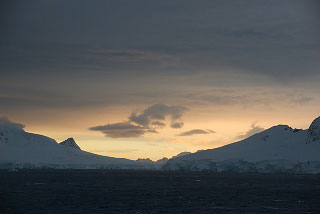

 | |||||||
|
|
Journals 2008/2009Megan O'Neill
May 18, 2009 The boat rocked most of the night. According to the captain, we had gusts of 84 knots and sustained of 45-50 knots! That is serious stuff. Fortunately, the boat was taking it well because the swells were not as large as they were in Dallmann Bay. We were tucked into Andvord Bay. We planned to survey the marine predators, but had to cancel plans due to the winds. The samples for CTD samples were also cancelled because of the wind gusts. Therefore, we had some quality time to get caught up on organizing data that had been collected so far. Because we have collected an overnight tag from our whale, "Jason," there are hours of audio recordings that have to be sorted. Allison and Lindsey have been plugged in for hours on end with headphones listening to the audio. They are able to categorize the sounds and decipher which are associated with the whales and other creatures. I got to listen to some of the recordings, as they worked and found neat sounds. One was a penguin in the background! So incredible! The sounds are truly otherworldly. Imagining what they are communicating and how much we miss from the surface from their world is fascinating! When they needed a break from the headphones, we plugged in the video game, Rock Band, and made some sounds of our own! Definitely entertaining! Finally the winds subsided enough in the evening to be able to deploy the MOCNESS - Multiple Opening & Closing Net Environmental Sampling System. Meng and Yiwu were using the system to create another piece of the puzzle of the picture of the krill availability. The MOCNESS is a huge contraption that has several nets with openings that are set for a particular depth. As the net is dragged behind the ship, each opening captures a sample of the water at the set depth. The net was set with nine openings. The ninth sampled all the way through the water column and closed at the depth of 450m. Then each net above was opened and closed at 50m intervals above that as it was pulled back up. An hour after deployment, the MOCNESS was pulled on to the back deck. Everyone geared up and headed out to view what was contained in the samples. The net confirmed what Meng and Yiwu had determined about the movement of the krill at night, which is they move closer towards the surface. The sample with the most krill was found in the 25-50m container. They pulled two tows with the MOCNESS and then continued with the CTD sampling through the night. This is also a very expensive "computerized fishing net" that costs around $200,000! Tomorrow we are hoping to get a survey in the Piccard Bay if the weather will cooperate.  |
||||||